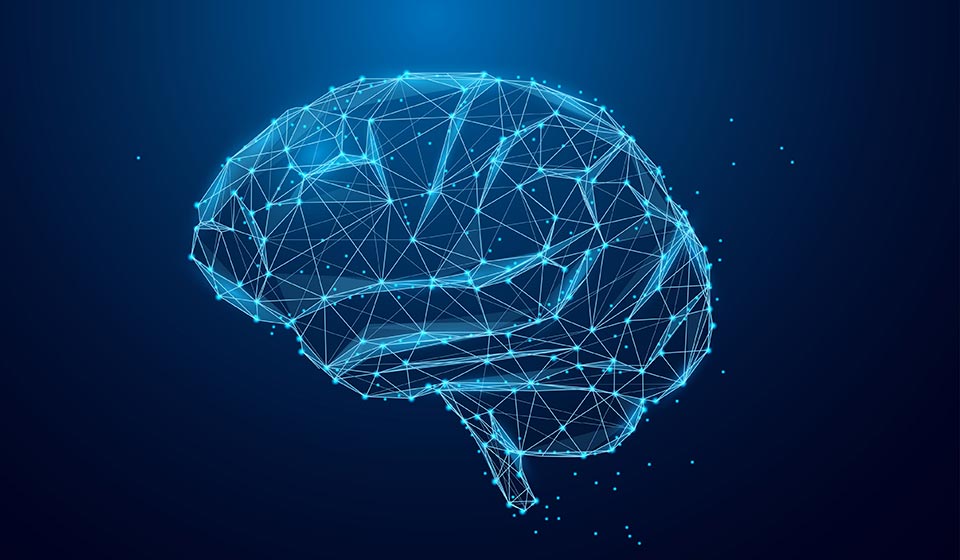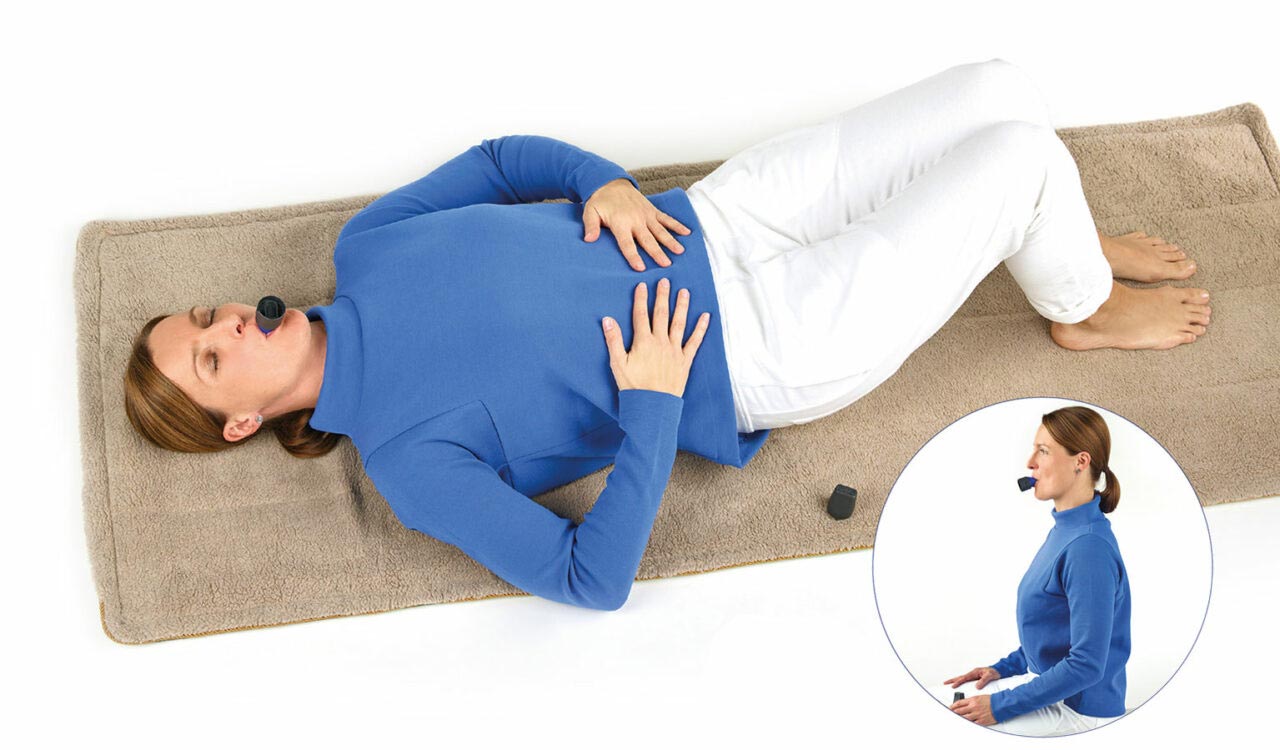Psychogenic breathlessness (dyspnoea)

What is psychogenic breathlessness (dyspnoea)?
“Psychogenic” means “having a psychological origin” or “attributable to psychological factors”. Psychogenic breathlessness (dyspnoea), also known as functional respiratory disorder, occurs when a mental trigger (rather than a physical one) elicits a feeling that a person is not getting enough air. Psychogenic breathlessness is, in fact, a condition that should be taken just as seriously as all others. Affected persons often feel the need to breathe more quickly and deeply, although their oxygen supply is generally normal.
Shortness of breath can be perceived by affected persons as a potentially life-threatening condition – regardless of cause. Even if a physical cause cannot be initially identified, psychogenic breathlessness must be taken absolutely seriously and treated with urgency. Ultimately, this is a medical condition that has even been assigned an ICD code (F45.3)1, i.e., an invoicing code for hospitals and doctors.
Physical or mental shortness of breath?
Shortness of breath can occur due to physical as well as psychological stresses, or in connection with other illnesses. Shortness of breath due to restrictive or obstructive pulmonary disease, such as asthma or COPD, occurs due to narrowing of the airways. Measurement of the expiratory peak flow using a peak flow meter can help the patient shift into a mindset in which they can clearly differentiate between the two medical conditions. Narrowing of the airways appears as increased fluctuations in the expiratory peak flow during the course of the day. In the case of psychogenic breathlessness, the normal peak flow value remains constant.
How can you tell if a person is suffering from physical or psychogenic breathlessness?
A patient’s vital measurements will provide a safe indication of whether their shortness of breath or short-windedness is psychological. Specifically, the patient’s peak flow, i.e. the maximum exhalation speed2, should be measured. This can be done most easily with a small, hand-held device – the peak flow meter – that patients can use by themselves. The lower limit and normal value for the individual peak flow should be determined together with the patient’s treating pulmonologist. Thus, in a case of dyspnoea it will only take seconds to determine whether this condition has a physical cause or whether it is psychogenic breathlessness.
Causes and symptoms of psychogenic breathlessness
Although the exact mechanisms that underlie psychogenic breathlessness are not fully understood, it is believed that stress and psychological burdens can lead to overstimulation of the autonomic nervous system. This system automatically regulates ongoing processes in the body, including the respiration. If there is overstimulation, this can result in overactivity of the respiratory muscles and the respiratory centre in the brain.
Patients often describe symptoms such as:
- Short-windedness or the feeling of not being able to breathe in deeply enough
- Accelerated or irregular breathing (hyperventilation)
- Tightness in the chest
- Tightness in the throat
- Dizziness and drowsiness
- Heart palpitations or tachycardia
- Fear that is accompanied by shortness of breath or that worsens it
These symptoms have the potential to evoke increased fear of physical illness in the affected person, such as developing a heart attack or an asthma attack, which in turn can worsen the shortness of breath.
Dyspnoea due to COPD, asthma and long-/post-COVID
Patients who have been diagnosed with asthma or COPD, as well as those affected by long- or post-COVID, also suffer frequently from breathing that is too fast and too shallow. Pulmonary emphysema is another condition that can produce such short-windedness, to name just a few examples. The reason is that these medical conditions belong to the category of obstructive pulmonary diseases. They narrow the airways – making deep inhalations and exhalations difficult. This has several effects on the body. Because of the shallow breathing, the exchange of gases is impeded – the intake of oxygen is thus restricted and, at the same time, less carbon dioxide is exhaled. When a person breathes shallowly, they must inhale and exhale more frequently. The breathing rate increases with the simultaneous shortness of breath, sending a signal to the body that it is experiencing stress. Stress hormones are released accordingly, aggravating the oppressive feeling even more3. If the affected person is unable to actively recover control over their breathing, this can quickly turn into dyspnoea.

Diagnosis of psychogenic breathlessness
The diagnosis of psychogenic breathlessness is often a diagnosis of exclusion. This means that physical causes for the respiratory ailment must have been carefully sought and ruled out. Tests commonly include:
- Pulmonary function tests, to rule out asthma or other obstructive or restrictive pulmonary diseases
- Blood tests to detect infections or biochemical imbalances
- Image-guided procedures such as X-rays or a CT of the chest, to rule out any structural changes in the lungs or the chest cavity
- An EKG or other cardiological examinations to rule out heart disorders
If no physical cause is identified and further symptoms suggest a psychological component, then the condition could be psychogenic breathlessness.
Treatment options for psychogenic breathlessness
The therapeutic options are as varied as the causes. They must be discussed and agreed upon for each individual patient, in coordination with the treating physicians and therapists. This is because the respiration is a complex process, and its treatment generally combines psychotherapeutic approaches to address the underlying emotional causes, together with respiratory techniques to improve the respiration and stress management.

Therapeutic approaches can include:
- Psychotherapy, such as cognitive behavioural therapy (CBT), to help you understand and overcome your stress triggers.
- Respiratory exercises and relaxation techniques, such as consciousness training, to improve breathing regulation and to reduce fear reactions.
- Medication, especially if the psychogenic breathlessness is associated with anxiety disorders or depression. In such cases, selective serotonin reuptake inhibitors (SSRIs) or benzodiazepines can be prescribed for the short term, whereby the latter must be used with caution due to the risk of addiction.
There is a broad scope of respiratory techniques and auxiliary devices that can offer support to alter the respiration and calm down the psyche. In principle, the body and mind are to be regarded as one unit, not separate from each other. They are closely connected to one another and mutually affect each other. This explains why a reduced respiration rate can produce general relaxation throughout the body, for example – and, inversely, how certain methods can be used to reduce or even stop shortness of breath.
Auxiliary devices for respiratory therapy, respiratory training and relaxation: the RC-FIT® CLASSIC
The RC-FIT® CLASSIC is an outstanding method of support for cases of dyspnoea. It is an innovative pep therapy device that trains and treats the respiratory tract via inhalation and exhalation. It does this in combination with oscillations (vibrations) and sounds.
Variable resistance during inhalations and exhalations can be built via the stricture and the valves integrated in the inlay. As a result, the intake of oxygen can be increased and the respiratory rate can be reduced. Thanks to a reduced respiration combined with the deep sounds obtained through use of this device, the body and psyche can attain calm.
Information on the product and its purchase can be found here. The RC-FIT® CLASSIC can be medically prescribed for chronic respiratory tract diseases.
The RC-FIT® CLASSIC can be used in a highly flexible manner irrespective of position while standing, sitting, or lying down, and during exercise such as walking, jogging, etc.
New options for using the connection between body and mind.
A brand new area in the field of sports science, involving the connection between the nervous system and the physical performance capability, is neuroathletics. The theory behind neuroathletics is that instead of exercising purely physically, the brain – i.e. the neurological system – is actively included during training, and the body’s performance capability is improved as a result. During neuroathletic exercise, the brain is also trained in the sense that it steadily unlearns certain protective mechanisms. One example would be conscious squinting. Here, the sensory stimuli that arrive at the middle brain differ from the stimuli in cases of “normal eyesight”. The effect is that the muscles in the head and neck area, and in the entire upper vertebral column, become stronger and more stable4.

The respiratory centre is a functional unit in our brain and is part of the autonomic nervous system. The parasympathetic branch of the nervous system is associated with our exhalation and plays an important role during relaxation.
Another example would be the conscious use of the tongue. As background, the tongue sends more sensory and motor stimuli to the brain than the entire torso. It activates an area in the brain stem that is responsible for coordination and balance. This explains why when sticking our tongues far out, we can turn our heads farther5.
Where is the connection to our breathing? It is clear that the brain, i.e. the neurological system, has a very significant effect on the body’s performance and function. Inversely, it is also possible to affect the body through targeted stimuli, including having an effect on the respiration.
Summary psychogenic breathlessness
Psychologically-related dyspnoea – psychogenic breathlessness – is a complex phenomenon that requires a knowledgeable and compassionate approach in terms of its diagnosis and treatment. Although physical symptoms are predominant, it is important to take into account and treat the psychological components. With the proper therapy, symptoms can be improved and even resolved.
1 MedKolleg, Portal für Medizin und Gesundheit. Psychogene Dyspnoe ICD-10 Diagnose F45.3. Abgerufen via www.med-kolleg.de/icd/P/22990.htm am 04.04.2022
2 Leichter atmen, 2021: Lungenfunktionstest – Normwerte. Abgerufen via www.leichter-atmen.de/lungenfunktionstest-werte am 01.04.2022
3 Dr. Gumpert, 2021: Psychisch bedingte Atemnot. Abgerufen via www.dr-gumpert.de/html/psychisch_bedingte_atemnot.html am 04.04.2022
4 Preuk, 2021: Neuroathletik für jedermann: Sie haben Rückenschmerzen? Neuro-Papst empfiehlt “Augen-Liegestütz”. Abgerufen via www.focus.de/gesundheit/gesundleben/fitness/neuroathletik-mit-training-des-gehirns-die-leistung-verbessern_id_10489268.html am 31.03.2022
5 Lienhard, L. (2019). Training beginnt im Gehirn: Mit Neuroathletik die sportliche Leistung verbessern (Riva Verlag)
Fotos: Thomas Vogel / istock.com, Jordi Calvera Solé / istock.com, Irina Shatilova / istock.com, Khanchit Khirisutchalual / istock.com

